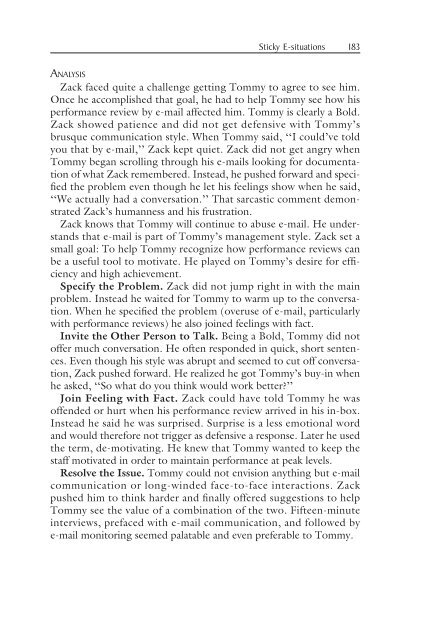Managing Sticky Situations at Work
Managing Sticky Situations at Work
Managing Sticky Situations at Work
Create successful ePaper yourself
Turn your PDF publications into a flip-book with our unique Google optimized e-Paper software.
<strong>Sticky</strong> E-situ<strong>at</strong>ions 183ANALYSISZack faced quite a challenge getting Tommy to agree to see him.Once he accomplished th<strong>at</strong> goal, he had to help Tommy see how hisperformance review by e-mail affected him. Tommy is clearly a Bold.Zack showed p<strong>at</strong>ience and did not get defensive with Tommy’sbrusque communic<strong>at</strong>ion style. When Tommy said, ‘‘I could’ve toldyou th<strong>at</strong> by e-mail,’’ Zack kept quiet. Zack did not get angry whenTommy began scrolling through his e-mails looking for document<strong>at</strong>ionof wh<strong>at</strong> Zack remembered. Instead, he pushed forward and specifiedthe problem even though he let his feelings show when he said,‘‘We actually had a convers<strong>at</strong>ion.’’ Th<strong>at</strong> sarcastic comment demonstr<strong>at</strong>edZack’s humanness and his frustr<strong>at</strong>ion.Zack knows th<strong>at</strong> Tommy will continue to abuse e-mail. He understandsth<strong>at</strong> e-mail is part of Tommy’s management style. Zack set asmall goal: To help Tommy recognize how performance reviews canbe a useful tool to motiv<strong>at</strong>e. He played on Tommy’s desire for efficiencyand high achievement.Specify the Problem. Zack did not jump right in with the mainproblem. Instead he waited for Tommy to warm up to the convers<strong>at</strong>ion.When he specified the problem (overuse of e-mail, particularlywith performance reviews) he also joined feelings with fact.Invite the Other Person to Talk. Being a Bold, Tommy did notoffer much convers<strong>at</strong>ion. He often responded in quick, short sentences.Even though his style was abrupt and seemed to cut off convers<strong>at</strong>ion,Zack pushed forward. He realized he got Tommy’s buy-in whenhe asked, ‘‘So wh<strong>at</strong> do you think would work better?’’Join Feeling with Fact. Zack could have told Tommy he wasoffended or hurt when his performance review arrived in his in-box.Instead he said he was surprised. Surprise is a less emotional wordand would therefore not trigger as defensive a response. L<strong>at</strong>er he usedthe term, de-motiv<strong>at</strong>ing. He knew th<strong>at</strong> Tommy wanted to keep thestaff motiv<strong>at</strong>ed in order to maintain performance <strong>at</strong> peak levels.Resolve the Issue. Tommy could not envision anything but e-mailcommunic<strong>at</strong>ion or long-winded face-to-face interactions. Zackpushed him to think harder and finally offered suggestions to helpTommy see the value of a combin<strong>at</strong>ion of the two. Fifteen-minuteinterviews, prefaced with e-mail communic<strong>at</strong>ion, and followed bye-mail monitoring seemed pal<strong>at</strong>able and even preferable to Tommy.















